-
01-01-2015
Women’s temporality after cardiac surgery: contributions to nursing care
Revista Brasileira de Enfermagem. 2015;68(6):1056-1062
Abstract
Women’s temporality after cardiac surgery: contributions to nursing care
Revista Brasileira de Enfermagem. 2015;68(6):1056-1062
DOI 10.1590/0034-7167.2015680609i
Views0See moreABSTRACT
Objective:
to unveil women’s existential movement after cardiac surgery.
Method:
qualitative phenomenological study. The research setting was a hospital in Minas Gerais, in which ten women were interviewed between December 2011 and January 2012.
Results:
after hospital discharge, the women experienced physical, social and emotional impairments, and expressed the desire to go back to the time before their diagnosis, because they felt as though they still had heart disease. This vague and average understanding led to three units of meaning that, from a Heideggerian hermeneutic point of view, revealed the phenomenon of cardiac surgery as a present circumstance that limited the participants’ daily lives.
Conclusion:
nurses supporting women patients after cardiac surgery should promote health considering existential facets that are expressed during care. The bases for comprehensive care are revealed in singular and whole meetings of subjectivity.
-
01-01-2015
Compliance of hand hygiene in maintaining the catheter for hemodialysis
Revista Brasileira de Enfermagem. 2015;68(6):1050-1055
Abstract
Compliance of hand hygiene in maintaining the catheter for hemodialysis
Revista Brasileira de Enfermagem. 2015;68(6):1050-1055
DOI 10.1590/0034-7167.2015680608i
Views0See moreABSTRACT
Objective:
to assess the compliance of the practice of hand hygiene in maintaining the temporary double-lumen catheter for hemodialysis, through the use of process indicator at the University Hospital of the University of São Paulo.
Method:
a quantitative, exploratory, descriptive, observational study. Sample consists of 155 observations of patients with catheter from March to November 2011, using the Maintenance Indicator Temporary Dual Lumen Catheter for Hemodialysis.
Results:
the overall compliance rate was 65.8%. Of the 13 specific components evaluated, 9 (69.2%) had 100% compliance. Hand hygiene by health professionals presented one of the worst rates (83.9%).
Conclusion:
it is necessary to implement strategies to reduce the rates of non-compliance, improve quality of care and safety of patients with catheter, and explore factors that affect the process, such as structural issues, and behavioral materials.
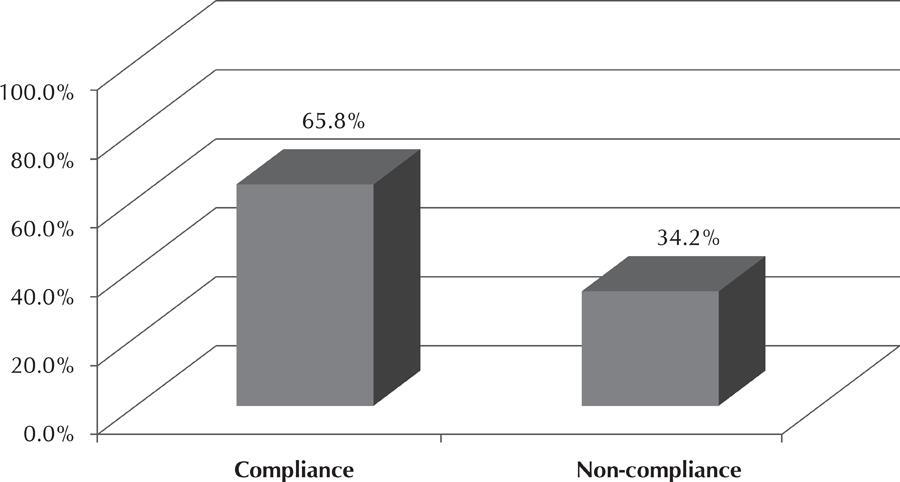
-
01-01-2015
Replication of the training program in nonverbal communication in gerontology
Revista Brasileira de Enfermagem. 2015;68(6):1042-1049
Abstract
Replication of the training program in nonverbal communication in gerontology
Revista Brasileira de Enfermagem. 2015;68(6):1042-1049
DOI 10.1590/0034-7167.2015680607i
Views0See moreABSTRACT
Objective:
to measure the rate of assimilation of applied content at immediate and subsequent moments after a nonverbal communication in gerontology training program.
Method:
descriptive and exploratory fi eld study developed in three state administered hospitals, which attend Brazilian National Health Service (SUS) clients. The duration of the training was twelve hours, applied with 102 healthcare professionals.
Results:
the results revealed that the rate of assimilation of the content immediately after the program was satisfactory, as well as being satisfactory in the aspects concept of aging; strategies to foster the independence and autonomy of the elderly person; communication interferences linked to the elderly and the professional; recognition of non-verbal functions and dimensions. The exception was the professional perception faced with aspects that influence the success of communication.
Conclusion:
it was concluded that the replication of this program was relevant and current for the hospital context, remaining effi cient for healthcare professionals.
-
01-01-2015
Physical and psychological violence against the elderly: prevalence and associated factors
Revista Brasileira de Enfermagem. 2015;68(6):1035-1041
Abstract
Physical and psychological violence against the elderly: prevalence and associated factors
Revista Brasileira de Enfermagem. 2015;68(6):1035-1041
DOI 10.1590/0034-7167.2015680606i
Views0See moreABSTRACT
Objective:
to verify the prevalence and associated factors to physical and psychological violence against elderlies and trace the sociodemographic and clinical indicators of this population.
Method:
household survey conducted in 729 elderlies Uberaba – MG. Data were analyzed by Chi-square test and logistic regression (p < 0,05).
Results:
the prevalence of elderly on violence was 20.9%, and 5.9% to 20.9% for physical and psychological. Among them prevailed women; with 60├80 years; no education; with income, with their partner as the primary aggressor; negative self-perception of health, hospitalization in the last year and presence of multimorbidities. The violence has been associated with have 60├80 years, living with your partner and dependence for instrumental activities of daily living.
Conclusion:
reinforces the need for early identification of domestic violence and invest in both the old protective actions and in maintaining functional capacity and social inclusion.
-
01-01-2015
First civil service examination for nurses at the Administrative Department of Public Service
Revista Brasileira de Enfermagem. 2015;68(6):1027-1034
Abstract
First civil service examination for nurses at the Administrative Department of Public Service
Revista Brasileira de Enfermagem. 2015;68(6):1027-1034
DOI 10.1590/0034-7167.2015680605i
Views0See moreABSTRACT
Objective:
to describe the results of the first national public service examination for nurses conducted by the Administrative Department of Public Service between 1941 and 1942.
Method:
historical-documentary research with a quantitative approach.
Results:
155 candidates registered, aged between 21 and 35 years old, 141 (91%) of whom were female. A total of 120 candidates passed the practical exam. Of these, 116 took the written qualification exam. In the end, 107 were approved, 74 (69.1%) of whom were temporary public nurses, 59 (55.1%) Anna Nery Nursing School alumni, and 10 among the first 20 twenty became involved with the Brazilian Association of Nursing later.
Conclusion:
although the exam legitimized the meritbased culture in the staff selection in the area of Brazilian nursing, egalitarian criteria were mitigated, especially regarding the grades applied to different kinds of exams. This resulted in a significant number of temporary nurses approved.
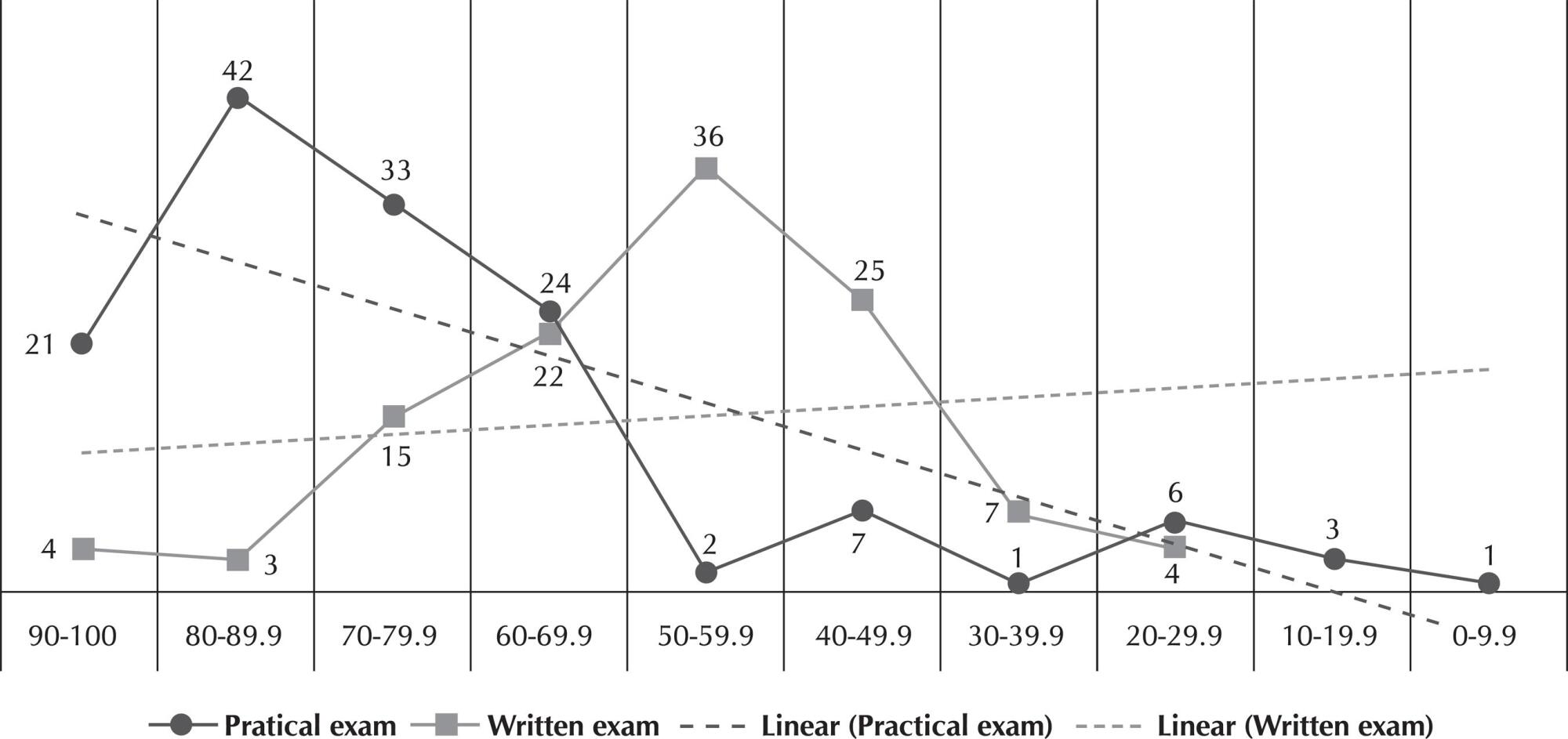
-
01-01-2015
Children and adolescents with chronic kidney disease in haemodialysis: perception of professionals
Revista Brasileira de Enfermagem. 2015;68(6):1020-1026
Abstract
Children and adolescents with chronic kidney disease in haemodialysis: perception of professionals
Revista Brasileira de Enfermagem. 2015;68(6):1020-1026
DOI 10.1590/0034-7167.2015680604i
Views0See moreABSTRACT
Objective:
to identify aspects impacting on quality of life for children and adolescents with chronic kidney disease on hemodialysis, from the perspective of health professionals, as an essential step for the construction of a specific module of the DISABKIDS® instrument.
Method:
methodological study. Data was collected between May and June 2012, through personal interviews with 12 participants, in two dialysis centers. The empirical material was analyzed according to the thematic content analysis, using the program MAXQDA – Qualitative Data Analysis Software.
Results:
we identifi ed seven themes: self-care, family support, impact of diagnosis, expectation of kidney transplant, truancy, socialization and stigma, grouped into three domains.
Conclusion:
the results showed aspects that impact the quality of life of these customers and, therefore, will be considered in the development of specifi c DISABKIDS® module. In addition, these aspects are relevant to the preparation and planning of actions directed towards children and adolescents with chronic kidney disease.
-
01-01-2015
From frustration to coping with caring for death by nurse technicians
Revista Brasileira de Enfermagem. 2015;68(6):1013-1019
Abstract
From frustration to coping with caring for death by nurse technicians
Revista Brasileira de Enfermagem. 2015;68(6):1013-1019
DOI 10.1590/0034-7167.2015680603i
Views0See moreABSTRACT
Objective:
to understand nurse technicians’ experience with caring for the death of terminal patients in ICUs and to configure a theoretical model.
Method:
qualitative study with theoretical saturation when analyzing the 10th non-directive interview, having as reference Grounded Theory, Symbolic Interactionism and Bioethics.
Results:
the core category – from frustration to coping with dignified nursing care for finitude: the acceptance of death as a therapeutic and intervenient component – emerged from the comparison of the sub-processes: when the nurse does not feel prepared for caring for death, accepting death as a therapeutic phenomenon and developing coping strategies.
Conclusion:
according to Symbolic Interactionism, a novice professional’s frustration in caring for an individual for death is related to his/her interaction and interpretation of the situation as he/she feels prepared only to care for individuals for life.
-
01-01-2015
Sedentary lifestyle in individuals with hypertension
Revista Brasileira de Enfermagem. 2015;68(6):1005-1012
Abstract
Sedentary lifestyle in individuals with hypertension
Revista Brasileira de Enfermagem. 2015;68(6):1005-1012
DOI 10.1590/0034-7167.2015680602i
Views0See moreABSTRACT
Objective:
to identify the prevalence of nursing diagnosis Sedentary lifestyle (SL) and to analyze its association with clinical indicators (CI) and related factors (RF) in patients with hypertension.
Method:
cross-sectional study with 285 patients with hypertension at a reference center for outpatient care in Northeastern Brazil. To collect data it was used an instrument based on operational defi nitions of the CI and RF previously validated. Four nurses rated SL as present or absent. To evaluate the association between CI and RF with the presence of SL it was applied the chi-square test. The prevalence ratio and confi dence interval was calculated to verify the magnitude of the effect between RF and SL. Results: SL was identifi ed in 55.8% of the sample. Five IC and six RF showed a signifi cant association with SL.
Conclusion:
the study identifi es main indicators for inference of SL as well as their possible causal factors among people with hypertension.
-
ORIGINAL ARTICLE09-09-2022
Palliative care management by caregivers in home care: theoretical validation in a conversation circle
Revista Brasileira de Enfermagem. 2022;75(6):e20210737
Abstract
ORIGINAL ARTICLEPalliative care management by caregivers in home care: theoretical validation in a conversation circle
Revista Brasileira de Enfermagem. 2022;75(6):e20210737
DOI 10.1590/0034-7167-2021-0737
Views0See moreABSTRACT
Objectives:
to present the validation process of a Grounded Theory on the management of palliative care at home by a caregiver of a family member who experiences a death/dying process.
Methods:
a qualitative, explanatory research, which validated a theoretical matrix through a conversation circle containing 15 family caregivers and nine healthcare professionals, in December 2018.
Results:
forty-six propositions were validated regarding family caregivers’ contextual, causal, intervening conditions, consequences and action strategies to deal with the dying and death process of a family member. Conversation circles encouraged dialogue and (re)signification of the senses and knowledge of those involved, proving to be a way of educating and promoting the exercise of citizenship by participants.
Final Considerations:
the conversation circle made it possible for participants to interact and share information and experiences regarding home care for palliative patients and their families.
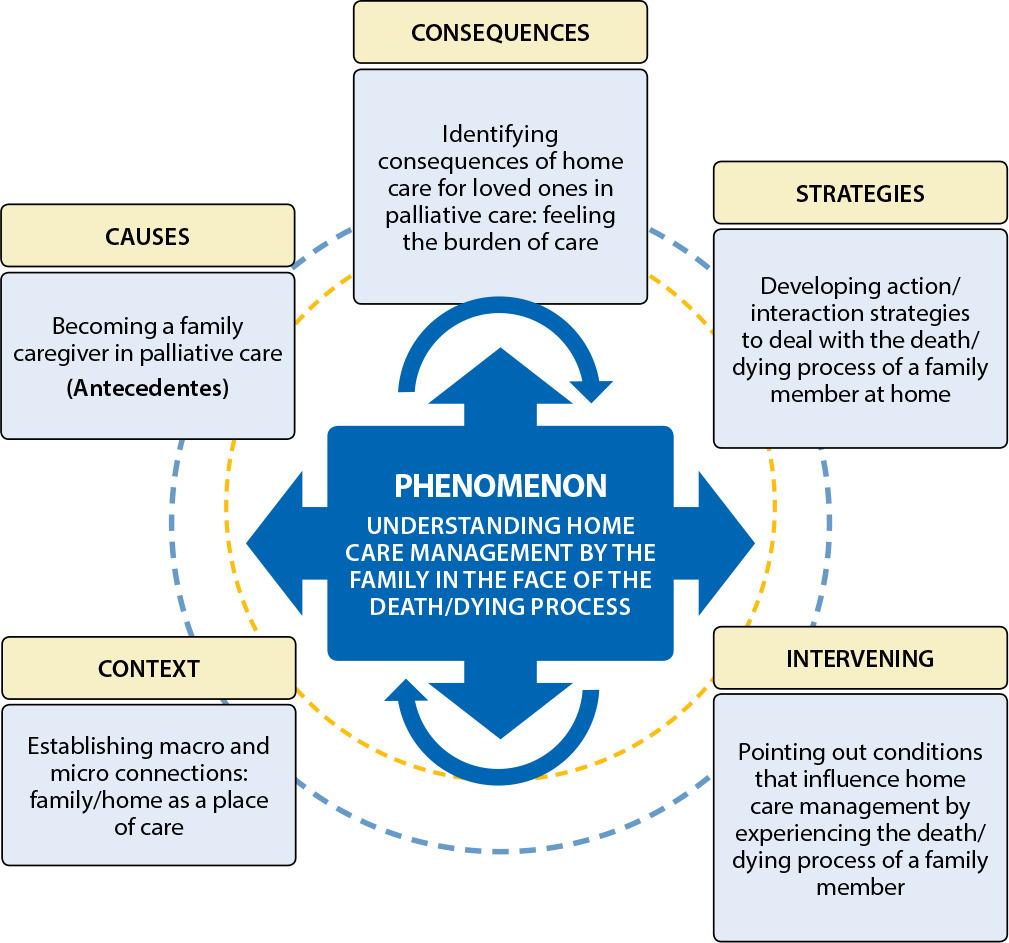
-
EXPERIENCE REPORT06-24-2022
Step-by-step approach to reopening a Brazilian higher education institution during the COVID-19 pandemic
Revista Brasileira de Enfermagem. 2022;75(6):e20210807
Abstract
EXPERIENCE REPORTStep-by-step approach to reopening a Brazilian higher education institution during the COVID-19 pandemic
Revista Brasileira de Enfermagem. 2022;75(6):e20210807
DOI 10.1590/0034-7167-2021-0807
Views0See moreABSTRACT
Objectives:
to describe the experience of reopening a Brazilian higher education institution during the COVID-19 pandemic.
Methods:
experience report of a step-by-set approach to reopening a nursing higher education institution in São Paulo, Brazil, from May 2020 to May 2021.
Results:
the plan was created and operated by a group including students, professors, and technical-administrative workers. Weekly or by-weekly meetings occurred according to changes in the epidemiological situation and the needs to review the local technical and political agreements.
Conclusions:
we suggest that reopening plans during the COVID-19 pandemic should be politically and technically legitimated by all members of the community of a higher education institution so that they can take place quickly and sustainably. The early identification of COVID-19 cases and the adoption of local administrative measures are necessary to reduce the risk of outbreaks.

-
ORIGINAL ARTICLE10-03-2022
Instrument validity: HIV and other sexually transmitted infections in homeless people
Revista Brasileira de Enfermagem. 2022;75(6):e20210863
Abstract
ORIGINAL ARTICLEInstrument validity: HIV and other sexually transmitted infections in homeless people
Revista Brasileira de Enfermagem. 2022;75(6):e20210863
DOI 10.1590/0034-7167-2021-0863
Views0See moreABSTRACT
Objectives:
to validate, through the Item Response Theory, an instrument on vulnerability to HIV and other sexually transmitted infections in homeless people.
Methods:
a cross-sectional study carried out between February and May 2018 with 100 homeless people in a municipality in northeastern Brazil. A sociodemographic questionnaire was applied, and another with items referring to behaviors vulnerable to HIV and sexually transmitted infections (STIs). Subsequently, it was assessed through the Item Response Theory.
Results:
the items previous diagnosis of STIs (F=0.473), partner with STI symptoms (F=0.518), drug use (F=0.509), sex for money (F=0.552), STI symptoms (F=0.448), number of sexual partners (F=0.616), sharps sharing (F=0.398) and being a victim of sexual violence (F=0.347) were validated.
Conclusions:
the instrument proved to be validated, being able to identify vulnerability to HIV and other sexually transmitted infections in homeless people.
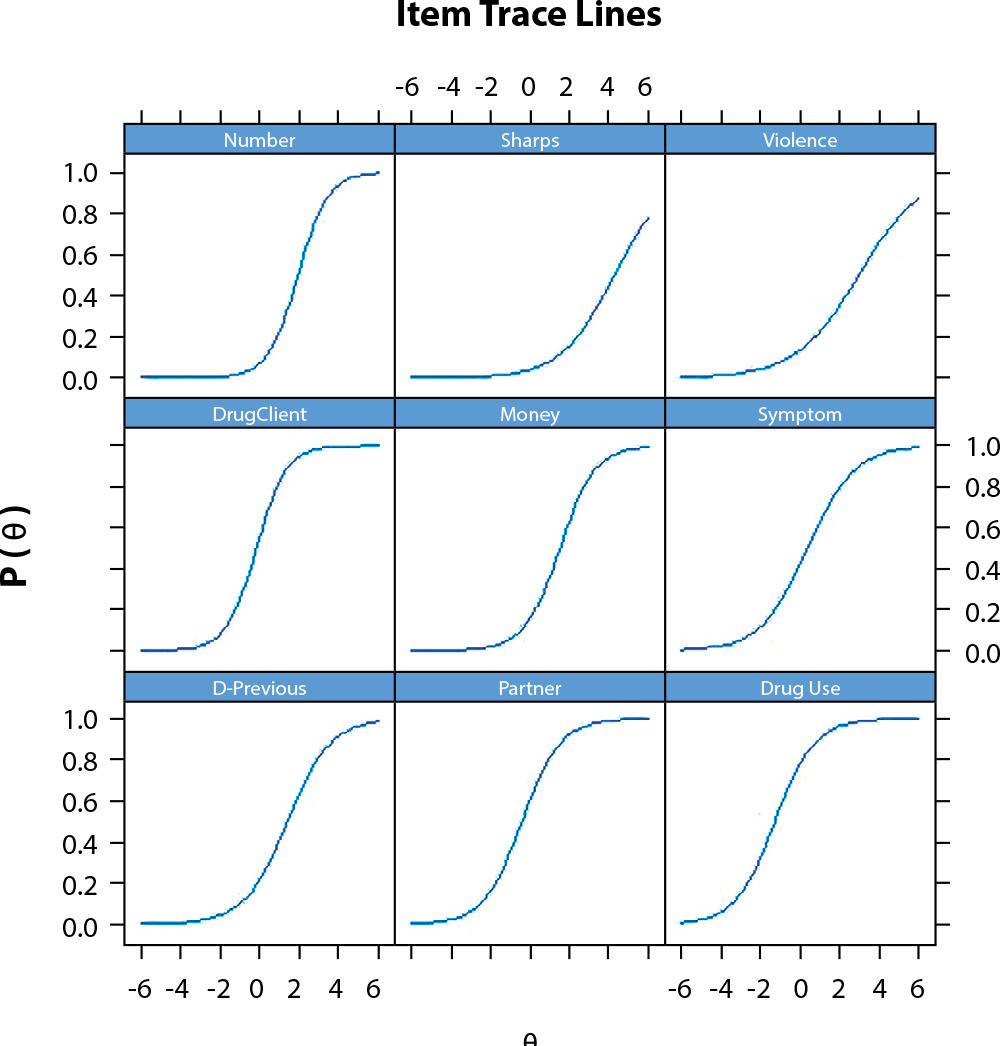
-
ORIGINAL ARTICLE08-22-2022
Temporal trend of accidents due to percutaneous exposure in a public hospital in Brazil, 2007-2019
Revista Brasileira de Enfermagem. 2022;75(6):e20220046
Abstract
ORIGINAL ARTICLETemporal trend of accidents due to percutaneous exposure in a public hospital in Brazil, 2007-2019
Revista Brasileira de Enfermagem. 2022;75(6):e20220046
DOI 10.1590/0034-7167-2022-0046
Views0See moreABSTRACT
Objectives:
to analyze the temporal trend of accidents due to percutaneous exposure in a public hospital in Brazil, between 2007 and 2019, according to sociodemographic and professional characteristics.
Methods:
analysis of time series of accidents due to percutaneous exposure that occurred in health workers. Sociodemographic and professional variables, accident profile, post-accident behavior and accident incidence rates were evaluated. The Prais Winsten regression was used for trend analysis and calculation of the annual percentage change, with a significance level of 5%.
Results:
761 occupational accidents were recorded. There was a downward trend in the rate of percutaneous injuries among female workers (-0.012%; p=0.009), who had secondary education (-0.011%; p=0.035) and among all health professional categories (-0.010%; p =0.019). There was an increasing trend (0.018%; p= 0.050) among workers with ≥ 61 months of professional experience.
Conclusions:
the analysis showed a decreasing incidence of percutaneous accidents, which can be explained by multiple factors.
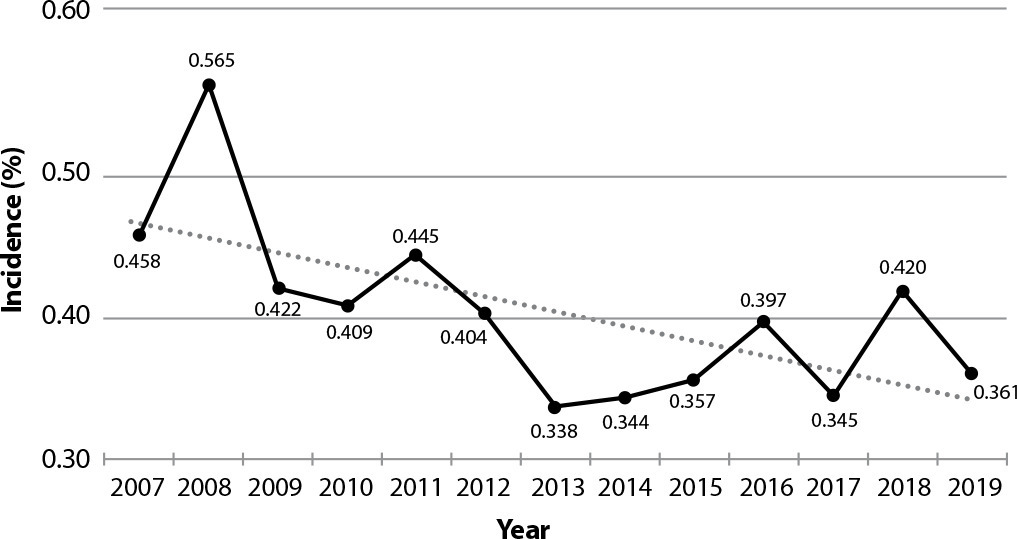
-
ORIGINAL ARTICLE11-26-2022
Health beliefs and adherence of the elderly to fall prevention measures: a quasi-experimental study
Revista Brasileira de Enfermagem. 2022;75:e20201190
Abstract
ORIGINAL ARTICLEHealth beliefs and adherence of the elderly to fall prevention measures: a quasi-experimental study
Revista Brasileira de Enfermagem. 2022;75:e20201190
DOI 10.1590/0034-7167-2020-1190
Views0See moreABSTRACT
Objective:
To evaluate the effect of an educational intervention on health beliefs and adherence of elderly people to fall prevention measures.
Methods:
This is a quasi-experimental study, carried out at the Senior Citizens’ Center. Sixty-eight elderly completed the intervention. The intervention consisted of four meetings focused on beliefs about falls and prevention, and the evaluation occurred at baseline and 30 days after completion.
Results:
The elderly were predominantly women (83.82%), with one to four years of schooling (36.76%), with health problems (95.59%), and 48.53% had fallen. There was a significant increase in perceived susceptibility, severity, benefits, barriers, and total health belief score post educational intervention. By adding total to partial adherence, there was a significant increase in the adherence of the elderly to fall prevention measures after the educational intervention.
Conclusion:
Educational intervention was able to improve the beliefs and adherence of the elderly to fall prevention measures.
-
ORIGINAL ARTICLE11-26-2022
Transitional care of nurses to older adults with artificial pacemaker
Revista Brasileira de Enfermagem. 2022;75:e20210192
Abstract
ORIGINAL ARTICLETransitional care of nurses to older adults with artificial pacemaker
Revista Brasileira de Enfermagem. 2022;75:e20210192
DOI 10.1590/0034-7167-2021-0192
Views0See moreABSTRACT
Objective:
to understand how the transitional care of nurses to olde adults with artificial pacemaker occurs.
Method:
a qualitative research, carried out in a philanthropic hospital in the city of Salvador, Bahia, Brazil. Fourteen nurses working in surgical and cardiac inpatient units participated. Data were collected between August and November 2020, through semi-structured interviews, and analyzed using the methodological framework Discourse of the Collective Subject and discussed in the light of Afaf Meleis’ theory of transitions.
Results:
nurses’ incipient knowledge about transitional care was identified. It was observed that the nursing discharge report is a facilitating instrument for transitional care.
Final considerations:
the study pointed out that the transitional care of nurses to older adults with artificial pacemakers does not have a theoretical foundation, reporting as a priority the care with the pacemaker identification card and with the surgical wound.
-
REVIEW02-25-2022
COVID-19 and the occupational stress experienced by health professionals in the hospital context: integrative review
Revista Brasileira de Enfermagem. 2022;75:e20200859
Abstract
REVIEWCOVID-19 and the occupational stress experienced by health professionals in the hospital context: integrative review
Revista Brasileira de Enfermagem. 2022;75:e20200859
DOI 10.1590/0034-7167-2020-0859
Views1See moreABSTRACT
Objective:
To analyze Brazilian and international scientific publications about the stress experienced by health professionals in the hospital context during the COVID-19 pandemic.
Methods:
Integrative literature review carried out on the SciELO, ScienceDirect, and LILACS databases, and sources of official Brazilian institutions, with documents published by May 2020.
Results:
Of the 26 selected references, 19 (73.08%) were indexed articles, and 7 (26.92 %) were obtained from official institutions. The study found that stress is mainly due to the overload of hospital services, the removal of professionals, the insufficiency of personal protective equipment and strict biosecurity measures, challenges in the allocation of available resources, and the risk of contamination by COVID-19.
Final considerations:
The stress experienced by health professionals in hospital institutions during the pandemic can trigger occupational and psychological problems.

-
ORIGINAL ARTICLE09-29-2022
Neither angels nor heroes: nurse speeches during the COVID-19 pandemic from a Foucauldian perspective
Revista Brasileira de Enfermagem. 2022;75:e20201329
Abstract
ORIGINAL ARTICLENeither angels nor heroes: nurse speeches during the COVID-19 pandemic from a Foucauldian perspective
Revista Brasileira de Enfermagem. 2022;75:e20201329
DOI 10.1590/0034-7167-2020-1329
Views1See moreABSTRACT
Objective:
to analyze the processes of meaning production, based on the speeches of nursing professionals, about how they feel about the titles of “angels and heroes” given by society during the pandemic of COVID-19.
Methods:
a qualitative, documentary research. Data was collected in October and November 2020 and analyzed from the perspective of the Discourse Analysis proposed by Michel Foucault.
Results:
they were organized into two thematic categories: “Angels and heroes? The (not) heroic reality of nursing during the pandemic” and “The search for recognition of the professional work of nursing: between what is said and what is not said”.
Final considerations:
the nurses’ speeches enunciate the search for decent conditions for the execution of care, fair wages, and recognition of the professional work by society.
Search
Search in:
Nuvem de Tags
Adolescente (85) Atenção Primária à Saúde (239) COVID-19 (91) Criança (91) Cuidados de Enfermagem (269) Educação em Enfermagem (151) Educação em Saúde (139) Enfermagem (930) Enfermagem Pediátrica (86) Estudantes de Enfermagem (77) Estudos de Validação (131) Família (87) Idoso (208) Promoção da Saúde (99) Qualidade de Vida (104) Saúde do Trabalhador (86) Saúde Mental (145) Saúde Pública (82) Segurança do Paciente (150) Tecnologia Educacional (100)



